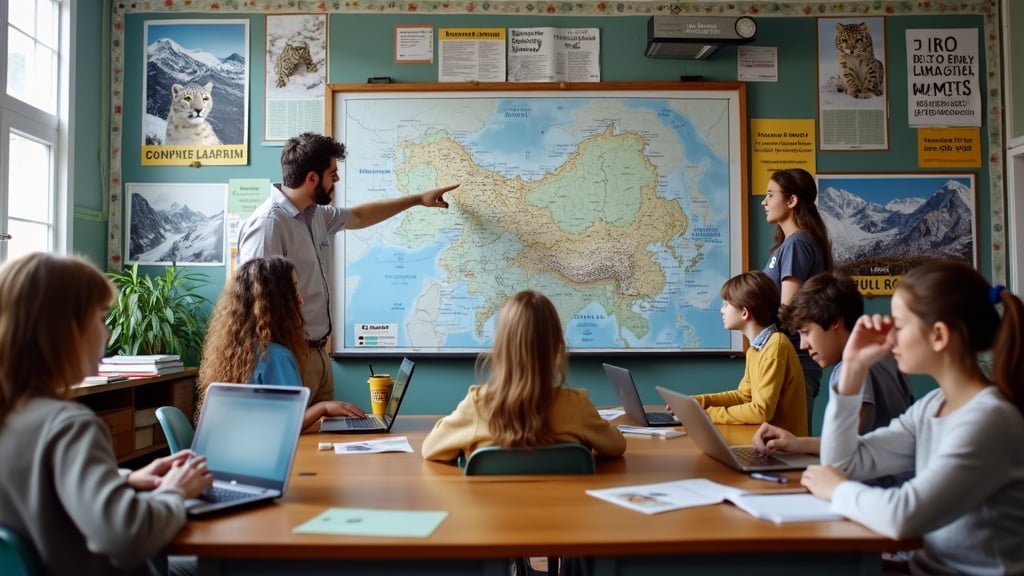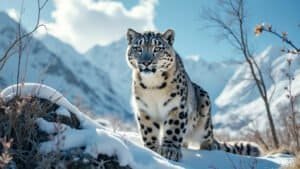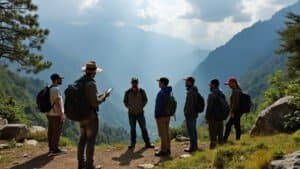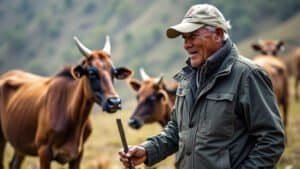Introduction
Including snow leopard conservation in school curricula offers a range of important benefits, from improving environmental education to fostering a sense of global responsibility in students
In this article, we will explore how teaching snow leopard conservation enhances students’ understanding of ecosystems and biodiversity, engages them with real-world challenges, and promotes sustainable practices
We will also examine the long-term benefits, such as preparing students for future careers in conservation and instilling a lifelong commitment to environmental stewardship. Through this analysis, you’ll gain insights into why snow leopard conservation should be an integral part of school education
How Snow Leopard Conservation Enhances Environmental Education
Teaching snow leopard conservation in school curricula is an impactful way to deepen students’ understanding of environmental science and conservation issues
Snow leopards, as apex predators in their ecosystem, provide a lens through which students can explore broader topics like biodiversity, climate change, and the interconnectedness of species
Including snow leopard conservation in education helps students appreciate the complexity of ecosystems while learning about the specific threats facing this endangered species
The Role of Snow Leopards in Ecosystems
Snow leopards play a crucial role in maintaining the balance of their ecosystems in the high mountain ranges of Central Asia. By preying on herbivores like blue sheep and ibex, snow leopards help regulate these populations, which in turn prevents overgrazing and supports plant life in the region
Teaching students about this predator-prey relationship offers a clear example of the importance of apex predators in maintaining biodiversity. Scientific studies have shown that removing predators like snow leopards from ecosystems can lead to ecological imbalances, demonstrating the fragility of these environments (McCarthy & Mallon, 2001)
By studying this dynamic, students learn about ecological principles such as trophic cascades, where the removal or addition of a species can lead to significant shifts in an ecosystem
This understanding helps to build a foundational knowledge of biodiversity and the importance of preserving various species within an ecosystem, all of which are essential elements of modern environmental education
Learning About Threats to Snow Leopards
Another critical aspect of including snow leopard conservation in school programs is educating students about the multiple threats facing these animals. Snow leopards are endangered due to habitat loss, human-wildlife conflict, and poaching for their fur and bones
The Global Snow Leopard and Ecosystem Protection Program (GSLEP, 2013) identifies habitat fragmentation due to infrastructure development and climate change as key threats. Additionally, human encroachment on snow leopard habitats leads to conflicts, as livestock herders sometimes kill snow leopards in retaliation for preying on their animals
By learning about these real-world threats, students not only become aware of the snow leopards’ plight but also understand the broader challenges that conservationists face when protecting endangered species
Studies such as Shrestha et al. (2005) highlight the importance of community-based conservation efforts that involve local people in the protection process, which offers students insight into potential solutions
Building Environmental Awareness Among Students
Introducing students to snow leopard conservation nurtures environmental awareness and a sense of responsibility for the natural world. According to a 2021 study by Alexander and Chen, conservation education has been shown to increase student engagement and empathy for wildlife
Students who learn about conservation topics like snow leopard protection develop a deeper connection to nature, understanding that human actions directly impact wildlife survival
This awareness extends beyond the classroom, as students often become ambassadors for conservation in their communities. Environmental education that includes species conservation fosters critical thinking, as students assess the complexities of conserving species within rapidly changing ecosystems
This holistic approach helps students see the broader picture of environmental stewardship, encouraging them to make sustainable decisions in their daily lives
Impact of Conservation Education on Student Engagement
Incorporating snow leopard conservation into school curricula can significantly enhance student engagement. Conservation education connects students with real-world issues, making learning more relevant and impactful
This type of education allows students to apply scientific knowledge to practical challenges, fostering both academic interest and personal investment in environmental topics. When students learn about snow leopards and their conservation, they are often motivated by the tangible, real-world implications of their studies
Engaging Students with Real-World Conservation Challenges
One of the most effective ways to engage students is to connect classroom content with current global challenges. Snow leopard conservation provides a powerful example of such an issue
As students learn about the threats to snow leopards—ranging from poaching to habitat loss—they gain a deeper understanding of the complex relationship between humans and wildlife. Conservation topics often go beyond theoretical concepts, allowing students to explore how human activity impacts ecosystems and species survival
According to research from the International Snow Leopard Trust (Jackson & Hunter, 1996), introducing students to ongoing conservation efforts, such as anti-poaching initiatives and habitat preservation, makes them more likely to become involved in similar projects, whether through classroom activities or community service
This hands-on approach creates a direct connection between students and the material, which, in turn, fosters more active participation and a greater desire to make a difference
Interactive Learning Through Field Trips and Research Projects
Conservation education is particularly effective when combined with interactive learning methods such as field trips, research projects, and virtual simulations
For example, students could visit local wildlife reserves, zoos with snow leopard conservation programs, or even participate in virtual exchanges with conservation groups in snow leopard habitats, such as those found in Nepal and Mongolia. Field trips provide an immersive experience that cannot be replicated in a traditional classroom setting, making the lessons more memorable
Moreover, research projects that allow students to investigate specific aspects of snow leopard conservation—whether it be the impact of climate change on their habitat or the effectiveness of community conservation efforts—can significantly deepen their engagement
These projects not only strengthen students’ research and critical thinking skills but also connect them to real scientific inquiry. According to Alexander and Chen (2021), students who participate in such experiential learning are more likely to retain information and stay engaged with the subject matter, as they feel they are contributing to meaningful, real-world issues
The Influence of Conservation Topics on Classroom Discussions
Classroom discussions about snow leopard conservation often provoke thoughtful, reflective conversations about ethical issues, human responsibility, and global citizenship. Because conservation touches on a variety of subjects—science, ethics, economics, and policy—students are encouraged to consider multiple perspectives
For instance, the dilemma of human-snow leopard conflict in rural mountain communities raises questions about balancing wildlife conservation with human livelihoods
Teachers can facilitate debates or group discussions around these complex issues, prompting students to think critically and articulate their own opinions. The inclusion of conservation topics, like snow leopard protection, offers an opportunity for students to develop their communication skills and engage in collaborative problem-solving
This type of active learning promotes deeper cognitive engagement, as students are not only absorbing information but also analyzing and evaluating it within broader socio-environmental contexts
Fostering Global Responsibility Through Snow Leopard Studies
Including snow leopard conservation in school curricula helps foster a sense of global responsibility in students. By studying the conservation of an endangered species that lives thousands of miles away, students learn that environmental issues transcend borders, emphasizing the need for international cooperation and shared responsibility
Snow leopard conservation serves as an important example of how human actions in one part of the world can affect ecosystems and wildlife globally
Connecting Local Conservation Efforts to Global Issues
Snow leopards inhabit some of the most remote and rugged mountain ranges in Central and South Asia, including the Himalayas, Altai, and Pamirs. Despite this geographical distance, their conservation has direct implications for global environmental health
For example, snow leopards are a keystone species, meaning their well-being is crucial for maintaining the health of the ecosystems they inhabit. If snow leopard populations decline, the balance of these ecosystems is disrupted, which can affect water sources, plant life, and other wildlife
Studies show that protecting these ecosystems helps to mitigate climate change impacts, as they act as significant carbon sinks (GSLEP, 2013)
By learning about snow leopard conservation, students are exposed to the idea that local conservation efforts are part of a larger global environmental challenge. They gain insight into how international conservation programs, like the Global Snow Leopard and Ecosystem Protection Program (GSLEP), coordinate efforts across national borders to protect species and habitats that are crucial to global biodiversity
This kind of learning helps students understand the interconnectedness of the world’s ecosystems and the shared responsibility we all have in preserving them
Understanding Human Impact on Wildlife
One of the core lessons students learn from studying snow leopards is the profound impact human activities have on wildlife. Human-snow leopard conflict is a significant issue, as communities living in the snow leopard’s range often lose livestock to the predators, leading to retaliatory killings
According to Shrestha et al. (2005), these conflicts have been a major driver of snow leopard population declines, and finding ways to reduce these tensions is essential for the species’ survival
Teaching students about these human-wildlife interactions helps them recognize the consequences of land use changes, agricultural expansion, and hunting practices on vulnerable species
Students can explore case studies of successful conservation initiatives, such as programs that compensate herders for livestock losses or introduce better livestock protection strategies. Learning about these efforts encourages students to think critically about how human activity influences the natural world and what role they can play in reducing negative impacts
Encouraging Sustainable Practices in Students’ Daily Lives
One of the long-term goals of conservation education is to encourage students to adopt sustainable practices in their daily lives. By understanding the threats facing snow leopards—such as climate change, poaching, and habitat destruction—students are more likely to reflect on their own behaviors and how they contribute to environmental problems
Simple actions, like reducing energy use, supporting ethical wildlife programs, or participating in conservation campaigns, can make a tangible difference in preserving endangered species
According to Alexander and Chen (2021), teaching conservation topics like snow leopard protection helps students develop a sense of responsibility toward the environment. They are more likely to engage in behaviors that reduce their ecological footprint and advocate for sustainable policies in their communities
This connection between classroom learning and personal action is crucial in building a generation of environmentally conscious global citizens who understand that their actions have far-reaching consequences for wildlife and ecosystems worldwide
Long-Term Benefits of Teaching Snow Leopard Conservation
Incorporating snow leopard conservation into school curricula has significant long-term benefits for both students and society
This type of education not only imparts critical knowledge about biodiversity and ecosystems but also encourages the development of future leaders in conservation and environmental stewardship
The lessons learned in classrooms about snow leopard protection can have far-reaching effects, influencing students’ career choices, lifestyle habits, and overall approach to sustainability
Promoting Biodiversity and Ecosystem Health
Teaching snow leopard conservation offers a unique opportunity to educate students about the importance of biodiversity and ecosystem health. As apex predators, snow leopards maintain the balance within their ecosystems by controlling the populations of herbivores
Without snow leopards, these herbivore populations would expand unchecked, leading to overgrazing and the degradation of vegetation, which has ripple effects throughout the ecosystem. By understanding the role that snow leopards play in maintaining the health of their environment, students gain a broader appreciation for the value of biodiversity
Research from the Global Snow Leopard and Ecosystem Protection Program (GSLEP, 2013) indicates that protecting the habitats of snow leopards contributes to the overall health of large ecosystems, such as the high-altitude mountain ranges of Asia, which provide critical water sources for millions of people
This highlights the fact that conservation efforts aimed at snow leopards benefit not only the species itself but also the broader environment and human communities. Through education, students can grasp the interconnected nature of biodiversity and human well-being, which is vital for developing a strong environmental ethic
Preparing Students for Careers in Conservation and Ecology
One of the long-term impacts of introducing conservation topics like snow leopard protection into school curricula is the potential to inspire students to pursue careers in conservation, ecology, and environmental science. By engaging with real-world environmental issues, students can discover a passion for solving problems related to wildlife preservation, climate change, and sustainability
Learning about the strategies used to protect endangered species—such as habitat preservation, anti-poaching measures, and international conservation policies—can guide students toward careers that focus on protecting natural resources and preserving biodiversity
Research by Alexander and Chen (2021) shows that exposure to conservation education increases students’ interest in science, technology, engineering, and math (STEM) fields, particularly those related to environmental science. By fostering an early interest in conservation, schools can play a key role in shaping the next generation of conservationists, ecologists, and environmental policy makers
These future professionals will be better equipped to address the complex challenges facing endangered species and ecosystems in a rapidly changing world
Instilling Lifelong Environmental Stewardship
The lessons learned through snow leopard conservation go beyond academics, as they have the potential to instill a lifelong commitment to environmental stewardship. Students who are taught about the importance of protecting endangered species are more likely to carry these values into adulthood
According to studies, students exposed to environmental education are more inclined to engage in pro-environmental behaviors, such as recycling, reducing energy consumption, and supporting conservation initiatives (Alexander & Chen, 2021)
By fostering this mindset at a young age, snow leopard conservation education creates a ripple effect, encouraging students to take action in their communities and advocate for environmental causes throughout their lives
They may also inspire others, including family members and peers, to adopt more sustainable practices. This shift in attitudes is crucial for building a society that values and protects the natural world
Ultimately, teaching snow leopard conservation can help create a generation of environmentally conscious citizens who understand that their actions—both individually and collectively—can make a difference. Whether through career choices, personal habits, or community involvement, students who have been educated about conservation are more likely to contribute to the long-term health and sustainability of the planet
Conclusion
Incorporating snow leopard conservation into school curricula provides a wealth of benefits for students and society. By learning about the vital role snow leopards play in ecosystems, students gain a deeper understanding of biodiversity and the complex interdependencies of species
Conservation education also enhances student engagement, offering real-world challenges that make learning more interactive and meaningful. These lessons foster a sense of global responsibility, as students recognize the connections between local conservation efforts and broader environmental issues, promoting sustainable practices in their daily lives
The long-term benefits of teaching snow leopard conservation are significant. Students are not only prepared for potential careers in environmental science and conservation, but they also develop a lifelong commitment to environmental stewardship
The knowledge and values instilled through these lessons inspire students to make conscious decisions that contribute to the health of the planet and the preservation of endangered species
Ultimately, integrating snow leopard conservation into education is a powerful tool for shaping informed, responsible global citizens who will continue to advocate for wildlife and ecosystems for years to come








